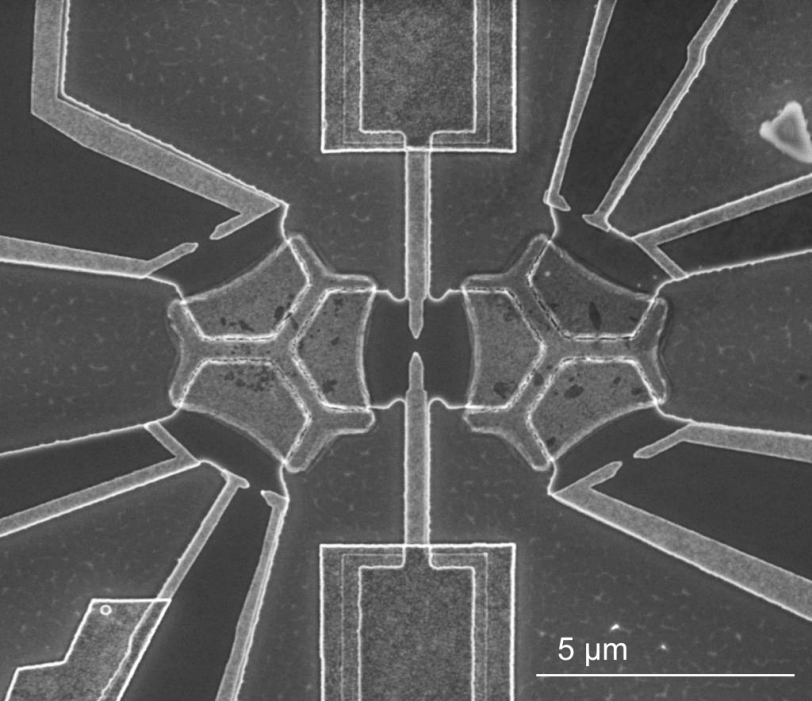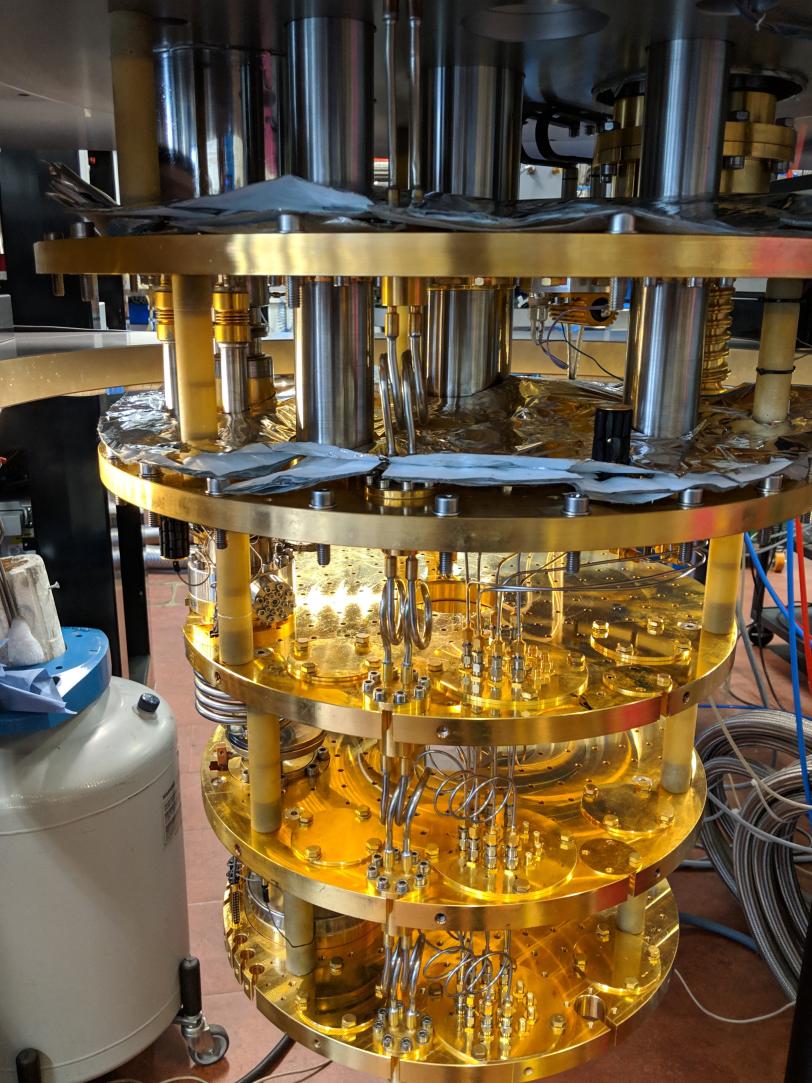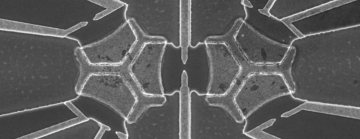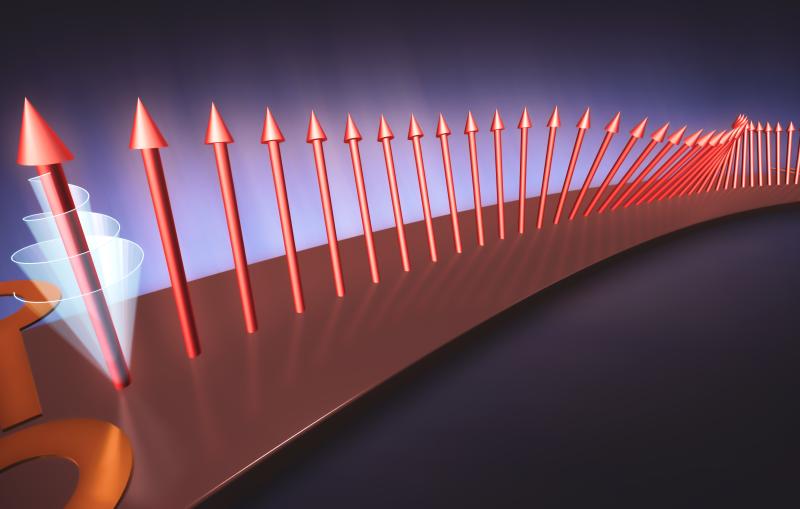Researchers take a step toward novel quantum simulators
If scaled up successfully, the team's new system could help answer questions about certain kinds of superconductors and other unusual states of matter.
Some of the most exciting topics in modern physics, such as high-temperature superconductors and some proposals for quantum computers, come down to the exotic things that happen when these systems hover between two quantum states.
Unfortunately, understanding what's happening at those points, known as quantum critical points, has proved challenging. The math is frequently too hard to solve, and today's computers are not always up to the task of simulating what happens, especially in systems with any appreciable number of atoms involved.
Now, researchers at Stanford University and the Department of Energy's SLAC National Accelerator Laboratory and their colleagues have taken a step toward building an alternative approach, known as a quantum simulator. Although the new device, for now, only simulates the interactions between two quantum objects, the researchers argue in a paper published January 30 in Nature Physics that it could be scaled up relatively easily. If so, researchers could use it to simulate more complicated systems and begin answering some of the most tantalizing questions in physics.
"We're always making mathematical models that we hope will capture the essence of phenomena we’re interested in, but even if we believe they're correct, they're often not solvable in a reasonable amount of time" with current methods, said David Goldhaber-Gordon, a professor of physics at Stanford and a researcher with the Stanford Institute for Materials and Energy Sciences (SIMES). With a path toward a quantum simulator, he said, "we have these knobs to turn that no one's ever had before."

Islands in a sea of electrons
The essential idea of a quantum simulator, Goldhaber-Gordon said, is sort of similar to a mechanical model of the solar system, where someone turns a crank, and interlocking gears rotate to represent the motion of the moon and planets. Such an “orrery” discovered in a shipwreck dating back more than 2000 years is thought to have produced quantitative predictions of eclipse timings and planetary locations in the sky, and analogous machines were used even into the late 20th century for mathematical calculations that were too hard for the most advanced digital computers at the time.
Like the designers of a mechanical model of a solar system, researchers building quantum simulators need to make sure that their simulators line up reasonably well with the mathematical models they're meant to simulate.
For Goldhaber-Gordon and his colleagues, many of the systems they are interested in – systems with quantum critical points such as certain superconductors – can be imagined as atoms of one element arranged in a periodic lattice embedded within a reservoir of mobile electrons. The lattice atoms in such a material are all identical, and they all interact with each other and with the sea of electrons surrounding them.
To model materials like that with a quantum simulator, the simulator needs to have stand-ins for the lattice atoms that are nearly identical to each other, and these need to interact strongly with each other and with a surrounding reservoir of electrons. The system also needs to be tunable in some way, so that experimenters can vary different parameters of the experiment to gain insight into the simulation.
Most quantum simulation proposals don't meet all of those requirements at once, said Winston Pouse, a graduate student in Goldhaber-Gordon's lab and first author of the Nature Physics paper. "At a high level, there are ultracold atoms, where the atoms are exactly identical, but implementing a strong coupling to a reservoir is difficult. Then there are quantum dot-based simulators, where we can achieve a strong coupling, but the sites are not identical," Pouse said.
Goldhaber-Gordon said a possible solution arose in the work of French physicist Frédéric Pierre, who was studying nanoscale devices in which an island of metal was situated between specially designed pools of electrons known as two-dimensional electron gases. Voltage-controlled gates regulated the flow of electrons between the pools and the metal island.
In studying Pierre and his lab's work, Pouse, Goldhaber-Gordon and their colleagues realized these devices could meet their criteria. The islands – stand-ins for the lattice atoms – interacted strongly with the electron gases around them, and if Pierre’s single island were expanded to a cluster of two or more islands they would interact strongly with each other as well. The metal islands also have a vastly larger number of electronic states compared with other materials, which has the effect of averaging out any significant differences between two different invisibly tiny blocks of the same metal – making them effectively identical. Finally, the system was tunable through electric leads that controlled voltages.

A simple simulator
The team also realized that by pairing up Pierre's metal islands, they could create a simple system that ought to display something like the quantum critical phenomenon they were interested in.
One of the hard parts, it turned out, was actually building the devices. First, the basic outlines of the circuit have to be nanoscopically etched into semiconductors. Then, someone has to deposit and melt a tiny blob of metal onto the underlying structure to create each metal island.
"They're very difficult to make," Pouse said of the devices. "It's not a super clean process, and it's important to make a good contact" between the metal and the underlying semiconductor.
Despite those difficulties, the team, whose work is part of broader quantum science efforts at Stanford and SLAC, was able to build a device with two metal islands and examine how electrons moved through it under a variety of conditions. Their results matched up with calculations which took weeks on a supercomputer – hinting that they may have found a way to investigate quantum critical phenomena much more efficiently than before.
“While we have not yet built an all-purpose programmable quantum computer with sufficient power to solve all of the open problems in physics,” said Andrew Mitchell, a theoretical physicist at University College Dublin's Centre for Quantum Engineering, Science, and Technology (C-QuEST) and a co-author on the paper, “we can now build bespoke analogue devices with quantum components that can solve specific quantum physics problems.”
Eventually, Goldhaber-Gordon said, the team hopes to build devices with more and more islands, so that they can simulate larger and larger lattices of atoms, capturing essential behaviors of real materials.
First, however, they are hoping to improve the design of their two-island device. One aim is to decrease the size of the metal islands, which could make them operate better at accessible temperatures: cutting-edge ultralow temperature “refrigerators” can reach temperatures down to a fiftieth of a degree above absolute zero, but that was barely cold enough for the experiment the researchers just finished. Another is to develop a more reliable process for creating the islands than essentially dripping molten bits of metal onto a semiconductor.
But once kinks like those are worked out, the researchers believe, their work could lay the foundation for significant advances in physicists' understanding of certain kinds of superconductors and perhaps even more exotic physics, such as hypothetical quantum states that mimic particles with only a fraction of the charge of an electron.
"One thing David and I share is an appreciation for the fact that performing such an experiment was even possible," Pouse said, and for the future, "I am certainly excited."
The research was funded primarily by the DOE Office of Science, with the early stages supported by the Gordon and Betty Moore Foundation.
Citation: Winston Pouse, Nature Physics, 30 January 2023 (10.1038/s41567-022-01905-4)
For questions or comments, contact the SLAC Office of Communications at communications@slac.stanford.edu.
About SLAC
SLAC National Accelerator Laboratory explores how the universe works at the biggest, smallest and fastest scales and invents powerful tools used by researchers around the globe. As world leaders in ultrafast science and bold explorers of the physics of the universe, we forge new ground in understanding our origins and building a healthier and more sustainable future. Our discovery and innovation help develop new materials and chemical processes and open unprecedented views of the cosmos and life’s most delicate machinery. Building on more than 60 years of visionary research, we help shape the future by advancing areas such as quantum technology, scientific computing and the development of next-generation accelerators.
SLAC is operated by Stanford University for the U.S. Department of Energy’s Office of Science. The Office of Science is the single largest supporter of basic research in the physical sciences in the United States and is working to address some of the most pressing challenges of our time.






